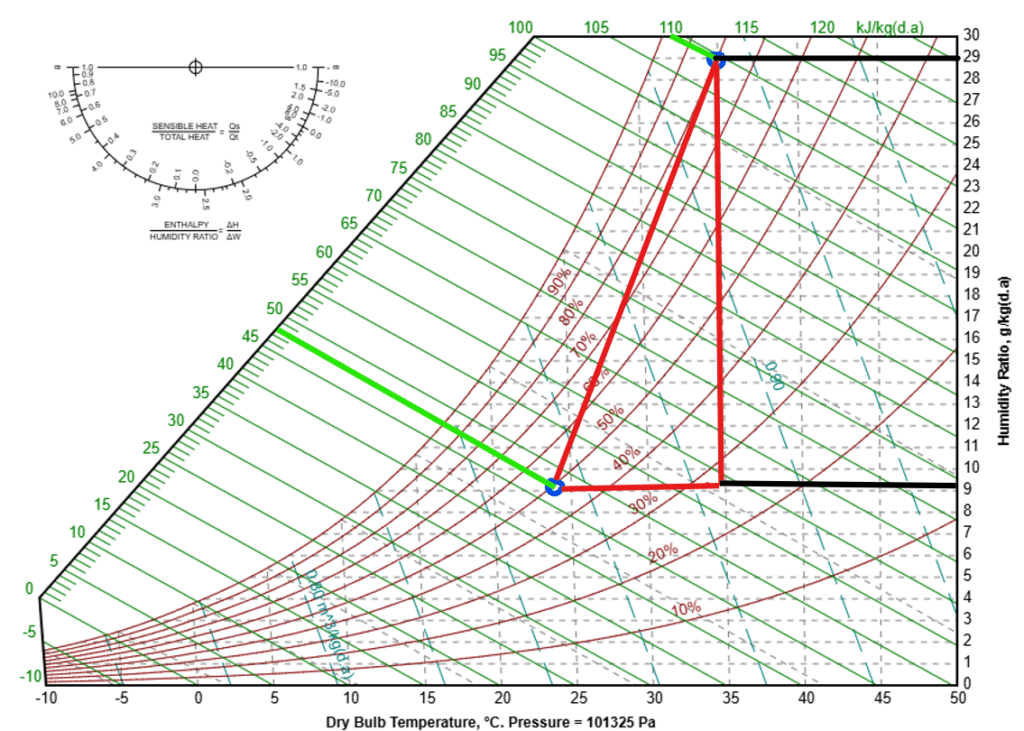Introduction
Understanding how to calculate the total heat load is essential for HVAC engineers, students, and facility managers. The total heat load determines the cooling capacity required for maintaining desired indoor conditions. It is a combination of sensible heat load (temperature-related) and latent heat load (moisture-related), and accurate calculation ensures optimal system sizing, efficiency, and comfort.
What Is Total Heat Load?
Total heat load is the sum of sensible and latent heat loads in a conditioned space. It represents the amount of heat energy that needs to be removed to maintain desired indoor conditions. This calculation typically involves:
- Outdoor and indoor climatic conditions
- Airflow volume (e.g., in CFM or m³/s)
- Air density
- Enthalpy difference (extracted from a psychrometric chart)
Sensible vs. Latent Heat
- Sensible Heat: Related to temperature changes without phase change.
- Latent Heat: Associated with moisture removal or addition, i.e., dehumidification.
Input Parameters for Heat Load Calculation
- Outdoor Conditions: 35°C DB, 80% RH
- Indoor Conditions: 24°C DB, 50% RH
- Outdoor Enthalpy: 109.71 kJ/kg
- Indoor Enthalpy: 47.83 kJ/kg
- Outdoor Humidity Ratio (approx.): 0.0273 kg/kg
- Indoor Humidity Ratio (approx.): 0.0093 kg/kg
- Airflow Rate: 1000 CFM (0.47194745 m³/s)
- Air Density: Approx. 1.2 kg/m³

Step-by-Step Total Heat Load Calculation
Step 1: Convert CFM to m³/s1000 CFM = 0.47194745 m³/s
Step 2: Calculate Mass Flow RateMass Flow Rate (kg/s) = Volume Flow Rate × Air Density= 0.47194745 × 1.2 = 0.576 kg/s
Step 3: Calculate Enthalpy DifferenceΔh = h_outdoor - h_indoor = 109.71 - 47.83 = 61.88 kJ/kg
Step 4: Total Heat LoadQ_total = Mass Flow Rate × Δh= 0.576 × 61.88 = 35.64 kW
Step 5: Convert to TR (Tons of Refrigeration)TR = Total kW ÷ 3.517 = 35.64 ÷ 3.517 = 10.14 TR
Calculating Sensible Heat Load Using formula:
Q_sensible = m × cp × ΔT
Where:m = 0.576 kg/scp ≈ 1.005 kJ/kg·KΔT = 35 - 24 = 11 K
Q_sensible = 0.576 × 1.005 × 11 = 6.36 kW
Calculating Sensible Heat Ratio (SHR)
SHR = Q_sensible ÷ Q_total = 6.36 ÷ 35.64 = 0.178
This means approximately 17.8% of the total cooling capacity is used to handle sensible heat, while the remainder addresses latent heat.
Calculating Latent Heat Load and Water Condensed
Step 1: Humidity Ratio DifferenceΔW = 0.0273 - 0.0093 = 0.018 kg water/kg air
Step 2: Mass Flow Rate of Dry Airm = 0.576 kg/s
Step 3: Mass of Water Condensed Per SecondCondensate mass = m × ΔW = 0.576 × 0.018 = 0.01037 kg/s
Step 4: Latent Heat LoadQ_latent = Condensate mass × h_fg = 0.01037 × 2500 = 25.93 kW
This aligns with the remaining part of the total heat load:Total - Sensible = 35.64 - 6.36 = 29.28 kWΔW = 0.0273 - 0.0093 = 0.018 kg water/kg airCondensate mass = 0.576 × 0.018 = 0.01037 kg/sLatent Heat Load = 0.01037 × 2500 = 25.93 kW
This aligns with the remaining part of the total heat load: 35.64-6.36 = 29.28 kW
Importance of Psychrometric Charts in HVAC Design
Psychrometric charts are crucial for determining air properties like enthalpy, humidity ratio, and dew point. This chart is especially valuable for calculating both sensible and latent heat loads accurately. Refer to sources like ASHRAE Fundamentals Handbook for validated charts.
FAQs About Heat Load Calculation
Q1: What is the significance of total heat load in HVAC?
A: It defines the cooling capacity required to maintain thermal comfort indoors.
Q2: Why use specific enthalpy in calculations?
A: Enthalpy accounts for both sensible and latent heat, offering a comprehensive view of heat content.
Q3: How do humidity levels affect heat load?
A: Higher humidity increases latent load, requiring more energy for dehumidification.
Q4: Can I use online calculators instead of manual computation?
A: Yes, but manual calculations help in understanding underlying principles crucial for system design.
Q5: How often should you reassess heat load?
A: Whenever occupancy, usage, or building envelope changes significantly.


